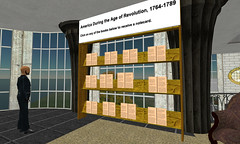Wait, Second Life still exists? And universities still use it?
By Kristopher A. Nelson
in
February 2010
500 words / 3 min.
Tweet
Share
I was surprised to read in the Chronicle of Higher Education that universities are still using Second Life, a “virtual worlds” system I honestly thought died in 2007. No one I know ever used it. Why is this, considering the people I know tend to be early adopters of pretty much everything technological?
Please note that this post is from 2010. Evaluate with care and in light of later events.
 I was surprised to read in the Chronicle of Higher Education that universities are still using Second Life, a “virtual worlds” system I honestly thought died in 2007. No one I know ever used it. Why is this, considering the people I know tend to be early adopters of pretty much everything technological?
I was surprised to read in the Chronicle of Higher Education that universities are still using Second Life, a “virtual worlds” system I honestly thought died in 2007. No one I know ever used it. Why is this, considering the people I know tend to be early adopters of pretty much everything technological?
Second Life always seemed to be the darling of traditional organizations — companies or universities — who seemed to like that it recreated “real space” online, unlike other online approaches (Twitter, Facebook, etc.) that required new ways of thinking and interacting.
Now, finally, these organizations are beginning to realize they might need to reconsider:
Some colleges that have built virtual classrooms in Second Life—the online environment where people walk around as avatars in a cartoonlike world—have started looking for an exit strategy.
The virtual world has not lived up to the hype that peaked in 2007, when just about every day brought a new announcement from a college entering Second Life.
Interestingly, the comments from educators in the Chronicle comments are generally quite supporting of Second Life, and many say virtual worlds are effective teaching environments, and criticize opponents as simply not understanding Second Life sufficiently.
Fair enough. Any technology, even one that attempts to recreate physical space via keyboards, mice and screens, has a learning curve. But I just don’t see a learning curve as being why Second Life hasn’t “made it,” beyond die-hard fans (who do seem to love it). Perhaps it’s the “griefers” and the anonymity, or the lock-in to a single vendor and their technology. Perhaps there’s something else. But, unfortunately or not, Second Life simply hasn’t succeeded. It’s out of step with a Web 2.0 world.
To succeed, I think, you need to get buzz with the early adopters of tech. These are the people who will advocate for you and help you innovate — but they won’t make your product a success by themselves. You also need to make your value clear — and not by explaining it — to newer adopters who may not be as “into” technology. Everyone needs to see “what’s in it for them,” as it were.
Perhaps a more successful approach would be to leverage Facebook’s app infrastructure and build a more limited “virtual world” in that space. Maybe Linden Labs can even port Second Life into this environment. But regardless, universities need to reconsider their approaches now, and they need to look outside of their own comfort zone to do it.